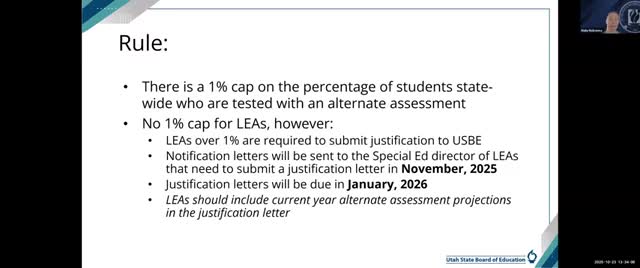USBE: State exceeds ESSA 1% cap for alternate assessments; 54 LEAs to submit justification letters
October 24, 2025 | Utah State Board of Education, Utah Government Divisions, Utah Legislative Branch, Utah
This article was created by AI summarizing key points discussed. AI makes mistakes, so for full details and context, please refer to the video of the full meeting. Please report any errors so we can fix them. Report an error »

Malia, a Utah State Board of Education staff member, told Local Education Agency (LEA) data managers that Utah exceeded the 1% alternate-assessment participation cap required under the Every Student Succeeds Act (ESSA) and that 54 LEAs will be required to submit justification letters.
The state-level cap limits the percentage of students who may be assessed with an alternate assessment to 1%. Malia said the state does not impose an individual-LEA cap; instead, any LEA with a rate above 1% will be asked to justify its rate. "Those notification letters, if you're 1 of those 54 LEAs, are gonna be sent out here, sometime in November. And then you'll have a justification letter will be due in January," she said.
Why it matters: states that exceed the cap must document reasons for higher participation and implement oversight. Malia said the U.S. Department of Education’s EDFacts system is used for the official calculation and that EDFacts counts opt-outs in the denominator (a difference from state accountability calculations). She noted statewide participation for students with disabilities in tested subjects was running in the high 80s percent range, below the 95% participation threshold that would have enabled Utah to request a waiver.
Staff outlined the projection and reporting process LEAs must follow. Projections must be done separately for each subject (language arts and math grades 3–10; science grades 4–10). The numerator should include only students the LEA expects will complete the alternate assessment to yield a valid proficiency-level result; students expected to be opted out should not be included. The denominator is all students the LEA expects will test (e.g., RISE, DLM, Utah Aspire Plus) at those grade levels.
Malia showed five-year trends indicating the alternate-assessment rates have risen about a half percentage point each year and said the state’s projected year-end rate is likely to be about 1.1% if trends hold. "So we really need to take this seriously," she said.
Consequences and next steps: USBE staff said the department will require a state plan to come into compliance and will conduct monitoring visits after justification letters are submitted. Because the state did not meet the 95% participation threshold, it did not qualify to request an ESSA waiver; instead USBE staff said they will pursue the other compliance steps the department can take and will provide trainings and communications to LEAs. Tracy Gulley was named as the internal contact for eligibility, monitoring and justification-letter questions; Malia said she will assist with data questions and projections.
LEAs were urged to work with their special education directors and data staff on the required projections and documentation and to anticipate additional trainings and updates at upcoming data and special education meetings.
The state-level cap limits the percentage of students who may be assessed with an alternate assessment to 1%. Malia said the state does not impose an individual-LEA cap; instead, any LEA with a rate above 1% will be asked to justify its rate. "Those notification letters, if you're 1 of those 54 LEAs, are gonna be sent out here, sometime in November. And then you'll have a justification letter will be due in January," she said.
Why it matters: states that exceed the cap must document reasons for higher participation and implement oversight. Malia said the U.S. Department of Education’s EDFacts system is used for the official calculation and that EDFacts counts opt-outs in the denominator (a difference from state accountability calculations). She noted statewide participation for students with disabilities in tested subjects was running in the high 80s percent range, below the 95% participation threshold that would have enabled Utah to request a waiver.
Staff outlined the projection and reporting process LEAs must follow. Projections must be done separately for each subject (language arts and math grades 3–10; science grades 4–10). The numerator should include only students the LEA expects will complete the alternate assessment to yield a valid proficiency-level result; students expected to be opted out should not be included. The denominator is all students the LEA expects will test (e.g., RISE, DLM, Utah Aspire Plus) at those grade levels.
Malia showed five-year trends indicating the alternate-assessment rates have risen about a half percentage point each year and said the state’s projected year-end rate is likely to be about 1.1% if trends hold. "So we really need to take this seriously," she said.
Consequences and next steps: USBE staff said the department will require a state plan to come into compliance and will conduct monitoring visits after justification letters are submitted. Because the state did not meet the 95% participation threshold, it did not qualify to request an ESSA waiver; instead USBE staff said they will pursue the other compliance steps the department can take and will provide trainings and communications to LEAs. Tracy Gulley was named as the internal contact for eligibility, monitoring and justification-letter questions; Malia said she will assist with data questions and projections.
LEAs were urged to work with their special education directors and data staff on the required projections and documentation and to anticipate additional trainings and updates at upcoming data and special education meetings.
View the Full Meeting & All Its Details
This article offers just a summary. Unlock complete video, transcripts, and insights as a Founder Member.
✓
Watch full, unedited meeting videos
✓
Search every word spoken in unlimited transcripts
✓
AI summaries & real-time alerts (all government levels)
✓
Permanent access to expanding government content
30-day money-back guarantee


